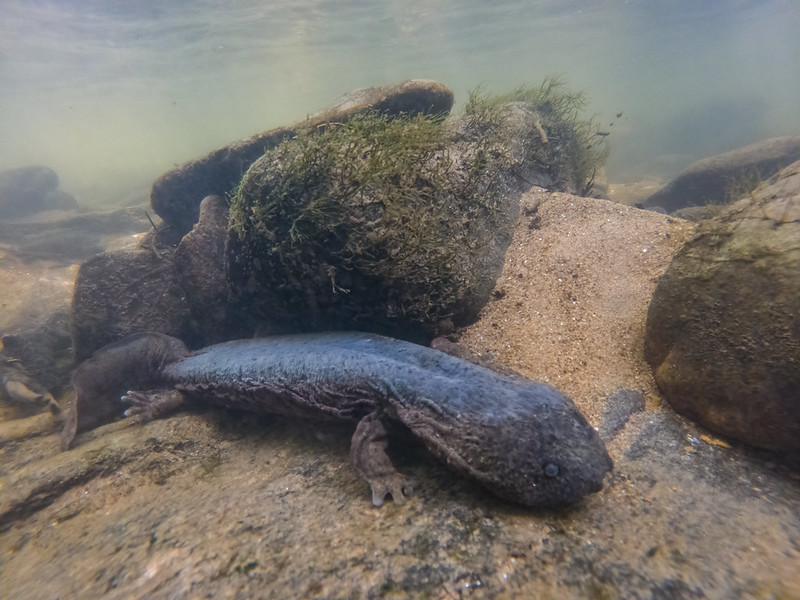
Hellbender Salamander Facts
- This astonishing creation of Nature and evolution most frequently goes by the attention-grabbing common name of Hellbender Salamander. The amazing animal does have at least one alternate title, though. That’s simply the extremely similar moniker of Hellbender.
- Within the scientific community, however, it’s probably much better known by its technical title. Unfortunately, that’s an extremely difficult designation for the layperson to pronounce. That’s because this amphibian bears the technical tag of Cryptobranchus alleganiensis.
- The animal received that tongue-twisting epithet due to the efforts of François Marie Daudin. The respected French zoologist accomplished the first recognition of it as a separate and distinct species. He managed that scientifically noteworthy deed in the year 1803.
- The intriguing creature stands out from others of its kind in several ways. For one, it ranks as the largest known salamander on its continent. It also represents the only surviving member of its genus known to science. These alone distinguish it from others within its range.
- Sadly, both the current territorial range and population base of the Hellbender Salamander seems to be dwindling rapidly. The decline in numbers additionally appears to hold true across its entire remaining range. The IUCN understandably currently list it as Vulnerable.
- The reduction of its native region largely occurs due to various human activities. Habitat degradation and its outright loss certainly rank high among these. Yet, the awesome animal also now faces the same threat posed by ongoing climate change as all species on earth.
Related Articles
Hellbender Salamander Physical Description
The remarkable Hellbender Salamander constitutes an impressive creature that garners a great deal of attention from those individuals who encounter it. Few people find salamanders visually appealing, per se, so most of that interest stems from the sheer physical size of the amazing animal.
In that respect, this natural wonder separates itself from many species, though. That’s due to the fact that it displays virtually no outwardly detectable degree of the physiological characteristic called sexual dimorphism. This makes distinguishing the two sexes at a glance extremely difficult.
Individuals of both genders of the amazing species therefore achieve the same basic dimensions. In terms of both its body and tail length, this varies quite significantly between specimens, however. On average, though, this specific measurement ranges from roughly 12 – 29 in (30 – 74 cm).
The mass of the highly unusual amphibian likewise varies accordingly, completely regardless of gender. For most observed individuals, though, this typically ranges from somewhere between 3.3 – 5.5 lbs (1.5 – 2.5 kg). Nonetheless, exceptional specimens of both sexes do occasionally occur.
Yet, the intriguinng Hellbender Salamander also has still other physical attributes to appeal to those with an interest in Nature. Unlike other salamanders in its region, this creature evolved a highly flattened body shape. It also has thick folds of skin hanging down the sides of the body.
It additionally evolved a flattened head, and the notably slimy skin common to its kindred. Meanwhile, the legs of the animal develop as relatively short. The front feet display four toes each, while the rear legs have five toes each. While adults have working lungs, they also retain gill slits.
- Kingdom: Animalia
- Phylum: Chordata
- Class: Amphibia
- Order: Urodela
- Family: Cryptobranchidae
- Genus: Cryptobranchus
- Species: C. alleganiensis
Hellbender Salamander Distribution, Habitat, and Ecology
The remarkable Hellbender Salamander evolved as native to a comparatively small section of the surface of the earth. The precise location of that zone of habitation, however, might suprise some people. That’s because it developed as endemic to a very small portion of North America.
Within that greater range, though, the animal only appears in a small section within the borders of the United States. Yet, even there it only lives in a tiny part of the eastern section. That territorial range includes all or part of a total of nineteen different state, from New York to Georgia.
Inside of that territorial range, the amazing amphibian typically displays decidedly strong preferences regarding its choices of habitat. In fact, these requirements remain so precise that it’s considered a true habitat specialist. It thus fills a very limited niche in a specific ecosystem.
Thus, the animal’s found almost exclusively in areas comprised of markedly narrow flows possessing fairly swiftly moving currents. It also needs the presence of numerous large, preferably flattened rocks. The creature generally avoids wider bodies of water that have slower rates of flow.
The mighty Hellbender Salamander evolved as carnivorous. Its principle prey appears to consist of small fish and crayfish. Yet, it also consumes other prey, such as worms, insects, molluscs, tadpoles, and even smaller salamanders. Adults of this species have very few predators themselves.
This wonder of Nature also displays a demonstrably strong territorial preference. Once an individual finds an area it likes, it rarely leaves voluntarily, except to mate or hunt. Though researchers remain uncertain, the animal also seems to be mainly nocturnal in its behavior patterns.
Species Sharing Its Range
Check out our other articles on 4 Stunning Bering Sea Species, Striped Skunk, Mississippi River, Indian Vulture, Rosy Veincap, Mountain Apollo, Spinetail mobula, Saltwater Crocodile
